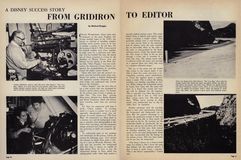
Cotton Warburton, whose name stirs memories of the great Southern Cal Trojan football teams of the 1930’s, has become as talented at handling complex traveling matte process scenes as he was at packing a pigskin in the old days. On the evening of April 5, 1965, Cotton moved his football trophies even closer together to make room for a glistening new addition. Not for football this time, the award was an Oscar presented to Cotton by the Academy of Motion Picture Arts and Sciences for his editing of the Walt Disney film, “Mary Poppins.” Just two weeks earlier, the American Cinema Editors recognized his accomplishment by awarding Cotton the highly valued “Eddie.”
Those who have seen the picture’s expertly executed traveling matte scenes combining live action, a painted background and animated cartoon characters in the same frame, can understand why Cotton deserves the statuettes.
“Mary Poppins” was the first film to use a new process that was developed by Disney’s special effects expert, Ub Iwerks. At the present time, Cotton is editing another film, “The Love Bug,” starring Dean Jones, Michele Lee, Buddy Hackett and David Tomlinson, which will feature more traveling matte than any previous film.
For those not acquainted with how it works, Cotton explains, “A traveling matte is a means to combine two or more separately photographed scenes into one picture. In certain sequences of “The Love Bug,” the foreground (i.e. Dean Jones in a cutaway car) and the background (existing or painted) were photographed at different times and places, and the component images produced were later combined during processing to make one composite picture.”
[…]